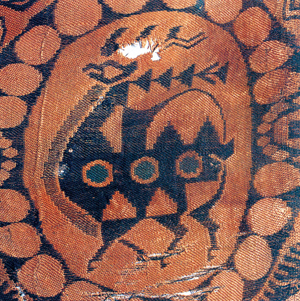
Written by: Jia Yingyi
Posted on: July 02, 2013 | 
A silk brocade arm cover
Rearing of silkworms, silk reeling, and silk weaving are great discoveries and inventions made by the Chinese people. Chinese silk was trendy in ancient Rome 2,000 years ago when Roman nobles were proud to dress in garments made of Chinese silk regardless of the outflow of money from the empire’s treasury. Scholars of Rome wrote to criticize that the empire was overturned by silk, but the caution was not heard.
 |
| Deer-figure brocade piece |
History narrates that one night, 2,050 years ago, Caesar, ruler of the Republic of Rome, went to see a play. The purple silk garment he dressed in that night caught the attention of the whole crowd with its tender luminous light and bright color. All the people there were admiring the beautiful fabric. At that time, the West considered Chinese silk as a fine apparel fabric. As an ancient Roman citizen stated, “Chinese silk is being weaved into splendid brocade and carried to Rome where noble women shall make dazzling dresses out of it.” It was even recorded that only Chinese silk could show the true beauty of a Roman damsel. But the prime cost of silk was very high. It needed to be carried from afar and was monopolized and levied with heavy taxation. Its price was comparable to that of gold when it finally reached the Eternal City, causing a serious outflow of money as a consequence. Hence, in order to suppress extravagancy, the Roman emperor forbade male citizens to wear silk. However, wearing silk had become a custom that could not be stopped as it was supposed to be. On the contrary, the prohibition turned into such an encouragement that people of all classes chose silk clothing. Roman merchants poured into China for silk while some scholars were “astonished” by the Roman nobles’ “extravagant behavior,” accusing them of “fetching clothing from distant Serres.”
Since the 20th century many Chinese silk products have been unearthed along the Silk Road, and in ancient Roman Empire domains such as Dula-oluopo and Halaibi on the east coast of the Mediterranean. Dozens of Chinese silk products have also been unearthed in Parmila, a Syrian trade city on the west end of the Silk Road. Among them, the Han Dynasty silk damask of diamond patterns (photo 1) is famous around the globe. Besides, Chinese thin silk and embroidery from the Han Dynasty are also said to have been discovered in Kenkur near Talas, Kirghizstan, in a 1st century Xiongnu (Huns) tomb. Silk fabrics from the 3rd century China have been unearthed in Tonpakkala, Uzbekistan, and brocade from the Tang Dynasty has been found in the mountain area of Mug, near the upstream of Zerafshan river of Tajikistan. Silk damask of diamond patterns from the early 2nd century B.C. has been discovered in Kerc on the Crimea peninsula of Russia. Chinese brocade from the Han Dynasty was also unearthed in Yrmewabad, on the south bank of Lake Baikal of Siberia, and in Ogelaheti and Konsik of Minusinsk. Damask and brocade from the 8th century were found as well in the Mossheveye Balka of North Caucasia, Katanda of Altay, and Argalikta of Khakassia. Even in the faraway land of the northern European country Sweden, Chinese silk products were found in the ancient tombs on the bank of the Meilaling Lake. In addition, Chinese thin silk, gauze, silk, embroidery, and brocade of stitched inscriptions were discovered in the Noin Ula ancient tombs while Tang Dynasty silk was found in Nainte-Sume of the People’s Republic of Mongolia. What is interesting is that the same silk products, such as the “Wishing for Longevity” brocade, were unearthed in the places of Loulan and Niya of Xinjiang and Oglaheti and Konsik of Russia, which means that Chinese silk products had disseminated throughout the whole Eurasia continent. And it is apparent that for the European market, Chinese people especially made silk fabrics suit to its taste (photo 2).
 |
| A caravan of camels on the silk road |
The rearing of silkworms, silk reeling, and silk weaving are great discoveries and inventions of the Chinese people. The West used to call China “Serice”, which means “the country of silk”, and silkworms “ser” and had many legendary myths about silk, such as depicting silkworms as spiders and their silk as the fur of the woods, etc. The Roman Empire longed for the silk reeling and weaving techniques but did not acquire them until the 6th century from the Hindu and Persian people. But when it comes to Central Asia and what is now Iran, many people of these places who were once nomadic immigrants from Europe should know about the technique. Ever since the 5th and 6th century these people have made silk products of their own style, such as the grand bead pattern brocade (photo 3) of Iran, the sadaniya brocade of Samarkand, etc.
You may also like: